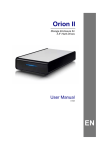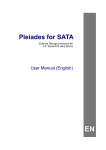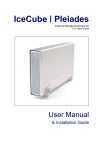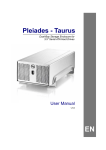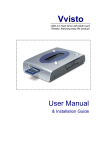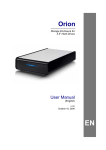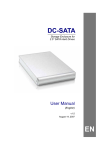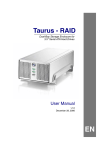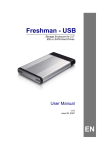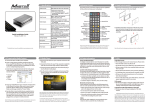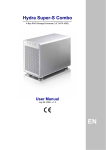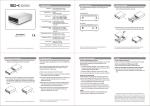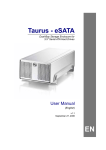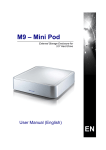Download Macpower & Tytech M9 - Mini Pod User manual
Transcript
M9 - Mini Pod External Storage Enclosure for 3.5” Serial ATA Hard Drives User Manual (English) EN Table of Contents CHAPTER 1 - INTRODUCTION -1- CHAPTER 3 - SYSTEM SET UP -5- ICON KEY -1- CONNECTION TO YOUR COMPUTER -5- THE M9 MINI POD -1- HARD DISK MODE -5- AVAILABLE INTERFACES -1- HUB FUNCTION -5- REAR VIEW -2- FAN SETTING -5- M9-S2 -2- INSTALLATION ON A PC -6- M9-S2H -2- WIN2000/WINXP WITH USB OR FIREWIRE - 6 - M9-DX2 -2- WIN2000/WINXP WITH SERIAL ATA -6- SYSTEM REQUIREMENTS -3- WIN98SE WITH FIREWIRE -6- PC REQUIREMENTS -3- UNPLUG PROCEDURE -6- MAC REQUIREMENTS -3- INSTALLATION ON A MACINTOSH -7- PACKAGE CONTENTS -3- MAC OS 9.X/10.X WITH FIREWIRE OR USB - 7 MAC OS 10.2 OR HIGHER WITH A USB 2.0, CHAPTER 2 - HDD ASSEMBLY -4- FIREWIRE 400 OR SATA CONNECTION -7- UNPLUG PROCEDURE -7- PARTITIONING & FORMATTING -8- PC RUNNING WIN98SE OR WINME -8- PC RUNNING WIN2000 OR WINXP -9- MAC OS - 10 - CHAPTER 4 - APPENDIX - 11 - TECHNICAL QUESTIONS - 11 - ABOUT THIS MANUAL - 11 - Chapter 1 - Introduction Icon Key Throughout this manual you will see icons on the left margin that denote either Notes or Special Remarks as outlined below: General Notes and Tips Remarks for PC users and Microsoft Windows OS Remarks for Mac users and Apple Macintosh OS The M9 Mini Pod Features mentioned in this manual may vary between different models. The External Storage Enclosure “M9” is made of high quality plastic with a smart interactive cooling system, which automatically regulates and varies fan speed according to temperature of the hard drive. Available with various types of interfaces, this is the perfect solution for additional external storage. Product Dimensions: 16.51cm x 16.51cm x 5.08cm 6.5in x 6.5in x 2in Available Interfaces • M9-S2 SATA & USB 2.0 High Speed • M9-S2H SATA, USB 2.0 & USB hub • M9-DX2 Firewire 400, USB 2.0 & USB hub -1- Rear View M9-S2 1. Exhaust Fan Vent 2. On/Off Switch 3. Power Receptacle 4. Fan Settings: Auto/Manual/High/Low 5. USB 2.0 Port 6. eSata Port 7. Micro Security Slot M9-S2H 1. Exhaust Fan Vent 2. On/Off Switch 3. Power Receptacle 4. Fan Settings: Auto/Manual/High/Low 5. USB 2.0 Hub 6. USB 2.0 Port 7. eSATA Port 8. Micro Security Slot M9-DX2 1. Exhaust Fan Vent 2. On/Off Switch 3. Power Receptacle 4. Fan Settings: Auto/Manual/High/Low 5. USB 2.0 Hub 6. USB 2.0 Port 7. Firewire 400 Ports 8. Micro Security Slot 1 2 7 3 4 5 6 1 2 8 3 4 5 6 1 2 7 8 3 4 -2- 5 6 7 System Requirements PC Requirements • • • • • Mac OS 8.6 users should use USB extension 1.41 or Firewire extension 2.6 and later, to be able to use USB 1.1 or 1394a. Minimum Intel Processor II 350MHz, 64MB RAM USB 1.1 equipped PC; WinME, Win2000, WinXP USB 2.0 equipped PC; WinME, Win2000, WinXP 1394a equipped PC; Win98SE, WinME, Win2000, WinXP Serial ATA equipped PC (eSATA); Win2000, WinXP Mac Requirements • • • • Minimum Apple G3 processor, 64MB RAM USB 1.1 equipped Mac; Mac OS 9.2, 10.1.5 or above USB 2.0 equipped Mac; Mac OS 10.2 or above 1394a equipped Mac; Mac OS 9.2, 10.1.5 or above • Serial ATA equipped Mac (eSATA); Mac OS 10.2 or above Package Contents Package Content may vary, depending on vendor & version. • M9 • External Power Adapter; Input 100-240V, Output 12V/2A, 5V/2A • Power Cord • Interface Cables • Manual -3- Chapter 2 - Hard Drive Assembly 1. Lift the top cover off the body. Your unit might come with an installed hard drive. Before opening such an enclosure, please read the warranty and any other notes from your vendor carefully before doing so, as this might void your warranty. 2. Install the hard drive and connect the cables to your drive. 3. Turn the enclosure around and fasten the four screws. Be careful not to damage any cables or components and do not bend the thermal probe. 4. Attach the thermal probe with the tape provided to the top of the drive, somewhere near the spindle motor. 5. Align the top cover with the body and push lightly into place. -4- Chapter 3 - System Set Up Connection to your Computer eSATA connection requires eSATA 1.5Gbps Plug and Play support for host card driver. A few tips on how to use your external storage enclosure: • The M9 was designed to be placed under a Mac Mini • Do not cover the enclosure’s exhaust vent • Do not expose the product to water or humid conditions Hard Disk Mode For the HDD connection, only one interface at the time can be used. If you buy a spare power adapter for your working place or at home, make sure the output and polarity is identical with the power adapter supplied! For M9-DX2, the disk drive will mount to the first connection that is presented. This will remain the default setting until the device is next restarted. For M9-S2 and M9-S2H, the eSATA connection has priority. When not in use, turn off the power. This goes especially for the M9-S2 and M9-S2H model, because for those, only SATA II hard drives support stand-by. The M9-DX2 supports stand-by and will go into stand-by depending on the status of your Operating System. Hub function In order for the USB Hub function to work, the USB cable must be attached to your computer and the power has to be ON. This function is only available for the M9-S2H and the M9-DX2. Fan Setting Make sure not to insert the Firewire 6-pin connector the wrong way around, or you will damage the device! There are 3 modes available for you to select the desired cooling. Automatic (Auto) / Manual Low (M/L)/ Manual High (M/H). We recommend you use the Auto mode. When this mode is selected the M9 automatically adjusts the fan speed up and down as necessary to keep the HDD cool. Ensure the thermal probe is attached to your drive to use the Auto mode. -5- Installation on a PC If the system doesn’t recognize the drive, turn on the power first, before connecting the interface cable or connect the device before booting your Operating System. Win2000 or WinXP with a USB or Firewire connection • • • • Turn on your Computer and start Windows Connect the M9 and turn it on Let Windows search and install the driver automatically Open “My Computer” to see your external hard drive ** Win2000 or WinXP with a Serial ATA connection • • • • Turn on your Computer and start Windows Connect the M9 and turn it on Let Windows search and install the driver automatically Open “My Computer” to see your external hard drive ** Win98SE with a Firewire connection eSATA connection requires eSATA 1.5Gbps Plug and Play support for host card driver. • • • • Turn on your Computer and start Windows Connect the M9 and turn it on Let Windows search and install the driver automatically Open “My Computer” to see your external hard drive ** Unplug Procedure For safe removal of your drive and to assure that no data is lost, always follow the unplug procedure. If not, an error message will show up. • Click on the taskbar icon for external hardware • Choose your external hard drive and confirm to remove it ** For factory new drives and formatting, see “Partitioning & Formatting” -6- Installation on a Macintosh If the system doesn’t recognize the drive, turn on the power first, before connecting the interface cable or connect the device before booting your Operating System. Mac OS 9.x or Mac OS 10.x with a Firewire or USB connection • • • • Turn on your computer and start Mac OS Connect the M9 and turn it on No driver installation required The external drive will mount and show up on your desktop** Mac OS 10.2 or higher with a USB 2.0, Firewire 400 or SATA connection • Turn on your computer and start Mac OS For Mac OS 8.6, the USB extension has to be at least v1.41. • Connect the M9 and turn it on • No driver installation required • The external drive will mount and show up on your desktop** Unplug Procedure • Drag the external hard drive icon into the trash bin • Turn off your device For Mac OS 8.6, the Firewire extension has to be at least v2.6. For save removal of your drive and to assure that no data is lost, always follow the unplug procedure. If not, an error message will show up. ** For factory new drives and formatting, see “Partitioning & Formatting” -7- Partitioning & Formatting You can choose to create several partitions but be aware that if you want to change this at a later point, it’s required to format the drive again or use 3rd party software. Be aware that this will destroy all your existing data on the drive, so make sure you have a backup! This step is usually only required the first time you install a factory new hard drive, if you change the format or want to erase all data on your drive. PC running Win98SE or WinME MS-DOS command “fdisk” (press Enter to confirm) • • • • • Type “fdisk” and press Enter Select ”Y” and press Enter Enter "5” to change the drive Select the drive you want to format Choose “1” and follow the onscreen instructions Win98SE and WinME do not recognize NTFS formatted drives, so if you want to use your drive on those platforms, we recommend you to use FAT32 instead. If you use this device to backup your data using a 3rd party software running MS-DOS, we recommend you to format the drive using FAT32. -8- PC running Win2000 or WinXP Mac OS can not write to NTFS formatted drives. To use your device on both platforms, we recommend you to use FAT32. Disk Management Program • Right click on “My Computer” and choose “Manage” • Select “Disk Management” • Choose the drive you want to format and right click on it for further commands (Choose New Partition) • Follow the Partition Wizard If you use Win2000 or WinXP and FAT32, the biggest single partition you can create will be 32GB. To create larger partitions, you need to use the DOS command under Win98SE or WinME or change to NTFS format. If you can not see the drive, make sure the drivers are installed properly and the power is turned on! -9- Mac OS If you want to use your drive on a PC running Microsoft Windows as well as on your Mac, we recommend you to use a PC to format the drive. Choose FAT32 when formatting and do not change anything on the partition or format on your Mac, otherwise the PC will not be able to recognize the drive anymore. Mac OS9.2 and earlier, does not support creating multiple partitions on an external drive. To do that, you would need to purchase additional 3rd party software, connect the drive to the internal SATA connection or upgrade to OS X. Initializing the drive can be done on all Operating Systems. For Mac OS X, use the Disk Utility to format and create partitions on your external disk. • Select “Disk Utility” in the utilities folder • Choose your external drive and format it according to your requirement If you can not see the drive, make sure there are no extension conflicts and the power is turned on! - 10 - Chapter 4 - Appendix Please read your warranty carefully, as this may vary between different vendors! Technical Questions For RMA and other questions, please contact your vendor or check out their online support area! About this Manual This manual covers all interfaces and combinations for the M9. Images and descriptions might therefore slightly vary between this manual and the actual product you have. © Copyright 2006 by Macpower & Tytech Technology Co., Ltd. all Rights Reserved The information contained in this manual is believed to be accurate and reliable. Macpower & Tytech Technology assumes no responsibility for any errors contained in this manual. Macpower & Tytech Technology reserves the right to make changes in the specifications and/or design of this product without prior notice. The diagrams contained in this manual may also not fully represent the product that you are using and are there for illustration purposes only. Macpower & Tytech Technology assumes no responsibility for any differences between the product mentioned in this manual and the product you may have. - 11 -













